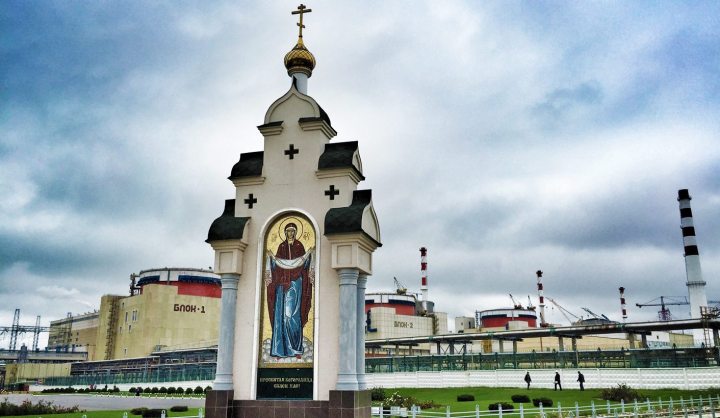World
Nuclear postcards from Russia

Few people can say they’ve set foot inside a Russian nuclear power station. ALEX ELISEEV recently found himself 35 metres from a live reactor core, contemplating the meaning of life and whether South Africa should be buying nuclear plants from Russia.
This story first appeared on EWN.
There’s a joke going around Moscow about two men talking politics, when one asks: “So, who do you think will be president in 2036?”
The second man clenches a fist, turns up his knuckles and uses them to count: “Putin … Putin … Medvedev … Putin … Putin … Medvedev … Putin … Putin…”
Beneath the humour lies the harsh reality of a country facing, at best, a difficult moment. The currency is in free fall, the economy is being poisoned by international sanctions, relations with the West are frosty (sliding back through time), political opposition has been crushed and you have to search hard to find any kind of independent news or dissenting voices.
Speak to some young Moscovites about the next five, 10 years and be prepared for anxiety and uncertainty, and sometimes even plans to find stability elsewhere. There are very real concerns of state lockdowns relating to foreign currency and immigration, as wealth continues to evaporate.
But Russia is a place of contrasts.
While political power stands like a brick fortress, unshakable and unbreakable, at street level people are using smartphone apps to vote for what kind of renovations they want to see in their neighbourhoods. In the purest form of democracy, residents decide what streetlamps they want installed or what finishes they’d like to see along historic sidewalks. You can snap a photograph of a pothole and, through another app, get it fixed within days.
There has been extensive rehabilitation of key buildings and public spaces, from modern jungle gyms in the hidden courtyards behind residential high-rises to the rebirth of treasures like Gorky Park. There’s free Wi-Fi on the metro, hipster craft markets around Arbat, gourmet burger joints, beautiful murals of authors and artists on the sides of apartment blocks, smart parking systems to open clogged up streets and Uber cabs to run you around the city. Just about everywhere you walk, you feel the stickiness of fresh asphalt under your feet and hear the clanking of construction. There’s no doubt that Moscow is a more beautiful, modern and open city than it was a decade ago.

Photo: Christ Redeemer
But the contrasts are stubborn. Across the road from an ancient Orthodox cathedral – it’s bells ringing for Sunday service – is a European-style French bistro, serving the tastiest cappuccino you’ll ever drink. Next to a rundown Soviet-era block of flats stand towers of luxury loft apartments worth millions of US dollars and with New York-inspired doormen. Electric supercars scream past grand statues to national heroes like Yuri Gagarin, who stands frozen in flight near Leninsky Prospekt. A Maserati showroom hides in the shadow of Stalinist architecture.
You can track every movement of a bus with GPS on your iPhone but just about any official visit or travel requires endless pieces of paper, filled out by hand and stamped by bureaucrats. Entering a university doing sensitive research may require sliding your passport to a soldier behind a one-way mirror. Phantoms of Lenin’s Russia linger not only in the subway tunnels, but in everyday life.

Photo: Moscow metro
It is somewhere inside these contrasts – old world versus new – that Russia’s nuclear industry finds itself.
With the first Russian nuclear power plant switching on in 1954, some 60 years ago, the technology was developed for a drastically different world to the one that exists today. The industry has not stood still, of course, and has modernised over the decades, but the fundamentals remain the same.
The Rostov nuclear power plant in Volgodonsk, south of Moscow, is one of the country’s newest. It’s a fine example showing nuclear power generation is not as terrifying as the world tends to think. Mention “Russia” and “nuclear” in the same breath, and the Chernobyl disaster appears on the horizon like a radioactive cloud. But Russia currently has 10 nuclear power plants with 34 reactors, all working without incident. Russia relies heavily on nuclear energy and, through the Rosatom company, is selling it abroad (complete with slick three-dimensional presentations) to nations like China, India, Turkey and Iran.
In 14 years, the Rostov nuclear power plant has never had a serious emergency, never mind a leak. Those who operate it say it has had no impact on the environment or its surroundings, which include a town with almost 200,000 residents. Even foreigners are allowed to enter its control room, which looks every bit as James Bond as you’d imagine. Visitors are led past the massive steam turbines which hum like giant metal beehives and radiate heat, making the building feel more like Dubai than provincial Russia. For a country that kept its atomic research hidden for so long, locking it up inside secret towns, opening the doors of a nuclear power plant to international guests is a big deal.
During our visit to Rostov, we were allowed a rare opportunity to enter the containment area where, in November, the fourth and final reactor will be installed. To be clear, we were able to step inside the sarcophagus which will be sealed off and kept clear once the core comes to life. At one point, we found ourselves 35 metres from a live nuclear reactor. While working in Japan in 2011, being 60 kilometres from an unstable power plant like Fukushima made my heart thump inside my chest. Once you start splitting atoms, no distance seems far enough. But at the Rostov plant, we ate borscht at the cafeteria and heard about how the third reactor was delivered ahead of schedule.
Nearby, at the Atommash factory, where nuclear vessels – the geyser-looking shells that house reactors – are built, we heard about the logistics of manufacturing these 12-metre long, 800-ton capsules. With the sparks of welding machines flashing and wall-to-wall cranes crawling lazily along the ceiling, we got a glimpse of the scale of the operation. It takes nine months for a human being to be born. It takes 36 months or more to build and test a reactor vessel.



Photos: Atomash factory
During the trip, there was a visit to an information centre and an exhibition marking the “70th anniversary of the Russian nuclear industry”. There were also a few hours to explore a Moscow university specialising in nuclear studies and related technologies. Students from across the world, including one from South Africa, are slogging away to be able to work in the field, devoting their careers to nuclear. I was interested to hear their views on whether atomic energy is the future or the past. They were armed and ready with their arguments; from the cost of construction to the required size of plants, from base-load capabilities to some countries battling with renewable resources. All the arguments are countered by those supporting alternative or green energy, but the students were adamant that “nuclear has a bright future”. One student from Nigeria used the example of air travel, arguing that plane crashes attract worldwide attention but don’t prove that driving on roads is any safer.
In essence, the latest trip for analysts and reporters (it was not the first) was designed to show that Russia not only does nuclear power well, it has the ability to export power plants. The factories are running, the new power stations are modern, safe and, most importantly, plugged into a thirsty grid.
The hosts were ready to field tough questions. What happens to all the waste? New technologies are being used to re-use it at other plants. What about Germany moving away from nuclear power? What about France and its huge reliance on nuclear? Will South Africa be responsible for a potential disaster? The “operator” is responsible, as per international conventions, which means Russia could share the burden. Delays in construction? We’re delivering ahead of schedule. Safety? There is a long list of global regulations and inspections. And so on …
But the core question (if you’ll forgive the pun) is not whether Russia is capable of harnessing nuclear power (it is), nor is it about whether it can export it (it can), it’s about whether South Africa should be buying it?
Break through the cement and peel back the sheets of steel, and it all comes down to one key issue: South Africans don’t trust their government with major infrastructure projects or multibillion(or trillion)-rand international purchases. So once you start talking about buying 9,600 megawatts of nuclear power from Russia, instruments which measure emotions begin to spin, smoke and explode.
To make matters worse, the South African government is not helping to build trust. It constantly contradicts itself about costs and the scope of its plans, it refuses to release feasibility or environmental assessment studies and when it is invited to give its side of the story, it fails to show up.
South Africa is not Russia.
It has a very different political set up. The e-tolling project in Gauteng has shown what happens when you don’t involve the public. Accountability is fought for and government decisions are reviewed in court. State transparency is what’s been missing from the nuclear deal, right from the start.
Other factors are just as important. Can South Africa afford this investment and what is it committing itself to in terms of future costs? How will global economics (including the Russian situation) affect decisions taken now? Will the construction of nuclear plants be delayed by turbulent labour relations? And will this cause the price to rise dramatically?
We may not have any natural disasters but is this the right environment for more nuclear? And then one of my biggest questions: can we produce enough brains – graduates – to run these plants, given the level of maths and science studies in this country? How many jobs will actually be created or will we have to import skills?
Should we be investing so much so soon, or should we spread the risk by considering one or two reactors and then seeing how things go? (The Rostov nuclear power plant reactors sprung up in 2001, 2010 and 2014, with the fourth due in 2017). How much of the energy mix should nuclear make up and how many technological advances will be made with renewable energy in the next two or three decades?
Like a boxer trying to psych out his opponent before the actual fight, the Russians have shown that they are able and ready to sell. Real or not, they appear to have the advantage. South African energy analyst Chris Yelland, who was on the trip, says the Russian technology is not in dispute.
“I’m blown away,” Yelland said, standing outside the Rosotov power plant. “We’ve been right inside the heart of the beast.”
His opinion is that nuclear should form part of the solution to this country’s energy needs, but not all of the eggs should go in one basket.
“This is not an engineering problem, it’s not a technology issue, it’s not about safety, it’s about management. We need to manage projects efficiently and effectively.”
There’s something else a visit to Russia will teach you. If you walk into any orthodox church, turn around and look above the door arch, you will always see the same scene: an artist’s impression of Judgment Day. Any decision taken about nuclear power now will affect South Africa for decades. It’s crucial we ask the right questions. DM
Alex Eliseev is an Eyewitness News reporter. Follow him at @alexeliseev
Main photo: The Rostov nuclear power plant in Volgodonsk, south of Moscow. (All photos by Alex Eliseev)



















 Become an Insider
Become an Insider